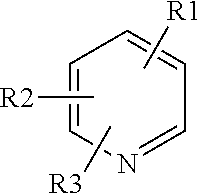Process for producing pyridine carboxylic acids
a technology of pyridine carboxylic acid and pyridine carboxylic acid, which is applied in the direction of organic chemistry, etc., can solve the problems of large waste water production, high salt production, and low yield and selectivity of these processes, and achieves high purity products, simple isolation steps, and cost-effective and commercially viable effects
- Summary
- Abstract
- Description
- Claims
- Application Information
AI Technical Summary
Benefits of technology
Problems solved by technology
Method used
Image
Examples
example 1
[0069]A 5 liter, 4 necked round bottomed flask fitted with agitator was charged with water. The oxalic acid was added with continuous stirring at 60-80° C. To this solution vanadium pentoxide and antimony trioxide (Sb2O3) were slowly added followed with titanium dioxide (TiO2). The reaction mass was maintained for 2 hrs at 60-80° C. and then evaporated to get it in a suitable paste for extrusion / pelletization / spray drying.
example 2
[0070]The catalyst was prepared by following the method as described in Example 1 except that antimony trioxide was not added.
example 3
[0071]The catalyst was prepared by following the method described in Example 1 except at pilot scale. 55 kg of catalyst was prepared by using 500 lit S.S reactor, pilot scale sigma mixer, extruder and calcinator for pilot plant study.
PUM
 Login to View More
Login to View More Abstract
Description
Claims
Application Information
 Login to View More
Login to View More - R&D
- Intellectual Property
- Life Sciences
- Materials
- Tech Scout
- Unparalleled Data Quality
- Higher Quality Content
- 60% Fewer Hallucinations
Browse by: Latest US Patents, China's latest patents, Technical Efficacy Thesaurus, Application Domain, Technology Topic, Popular Technical Reports.
© 2025 PatSnap. All rights reserved.Legal|Privacy policy|Modern Slavery Act Transparency Statement|Sitemap|About US| Contact US: help@patsnap.com

